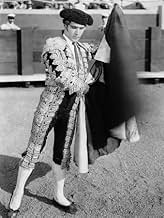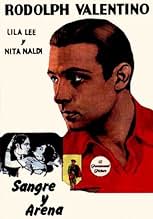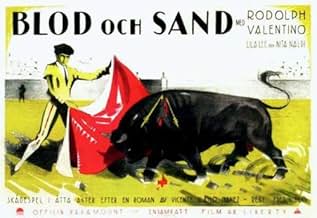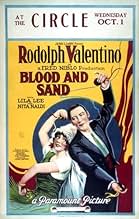IMDb RATING
6.3/10
1.6K
YOUR RATING
A toreador's (Rudolph Valentino) familial and social life is threatened when he has an affair.A toreador's (Rudolph Valentino) familial and social life is threatened when he has an affair.A toreador's (Rudolph Valentino) familial and social life is threatened when he has an affair.
- Directors
- Writers
- Stars
- Awards
- 1 win total
Rudolph Valentino
- Juan Gallardo
- (as Rodolph Valentino)
Rosa Rosanova
- Angustias
- (as Rose Rosanova)
W.E. Lawrence
- Fuentes
- (as William Lawrence)
Michael Dark
- Doña Sol's New Lover
- (uncredited)
- Directors
- Writers
- All cast & crew
- Production, box office & more at IMDbPro
Featured reviews
"Blood and Sand" tells us many times how cruel and dangerous it believes bullfighting to be, but in terms of what it actually shows us, it seems far more interested in the romantic qualities of Rudolph Valentino and his larger-than-life love triangle.
Valentino gives a legitimately good performance, but even the love story loses some of its immediacy from the fact that "Blood and Sand" takes its subject at some distance, periodically stepping back and focusing on the scholar who foreshadows the matador's end. This also allows some of the characterization to go without being fully realized. When all is said and done it is neither believable as an anti-bullfighting film nor totally involving as a story of a love triangle, but some of the elements, including the performances and some excellent symbolic imagery, are well realized.
Valentino gives a legitimately good performance, but even the love story loses some of its immediacy from the fact that "Blood and Sand" takes its subject at some distance, periodically stepping back and focusing on the scholar who foreshadows the matador's end. This also allows some of the characterization to go without being fully realized. When all is said and done it is neither believable as an anti-bullfighting film nor totally involving as a story of a love triangle, but some of the elements, including the performances and some excellent symbolic imagery, are well realized.
Although in many ways "Blood and Sand" looks rather old-fashioned now, it's still an interesting drama. It gives Rudolph Valentino one of his better roles, and it is also highlighted by an effective supporting performance from Nita Naldi. The subject matter has some substance to it, and it still holds up well enough despite being handled occasionally in a somewhat heavy-handed manner.
In playing the bullfighter Gallardo, Valentino gets a character with some depth to it. The story follows him as he first struggles to achieve fame and respect, and then struggles in dealing with the side-effects of fame, fortune, and popularity. Naldi's role is memorable, and from her first appearance she makes her manipulative vamp character physically desirable but an obvious source of danger. Valentino does a good job playing off of her, and even without the benefit of spoken dialogue it is easy to see the struggle and self-reproach taking place inside of him.
The themes have a significance that go beyond the original setting. In itself, the criticisms of bullfighting and of what it reveals about human nature, while generally quite valid, are put forth without any subtlety. The inter-titles and the obvious parallels between Gallardo and the notorious criminal Plumitas repeatedly emphasize the same points that the action itself could have made well enough on its own. But that's one of the few weaknesses of "Blood and Sand". And the more general point, its depiction of how easy it is for crowds to be thrilled with violence, is well-taken.
The one other noticeable shortcoming is that the bullring scenes are now often unconvincing. It is laudable, of course, that the film-makers were willing to sacrifice realism so as to avoid being cruel to the animals, so this particular aspect of the movie should be evaluated generously. Present-day technology would certainly have made it much simpler to achieve both goals.
Although the style might make it mostly of interest to those who are already silent movie fans, there is still more than enough of interest to make this worth seeing. The story is simple, but it has some worthwhile aspects. Naldi provides something striking to look at, and Valentino gets to show what he can do with a role that has some possibilities to it.
In playing the bullfighter Gallardo, Valentino gets a character with some depth to it. The story follows him as he first struggles to achieve fame and respect, and then struggles in dealing with the side-effects of fame, fortune, and popularity. Naldi's role is memorable, and from her first appearance she makes her manipulative vamp character physically desirable but an obvious source of danger. Valentino does a good job playing off of her, and even without the benefit of spoken dialogue it is easy to see the struggle and self-reproach taking place inside of him.
The themes have a significance that go beyond the original setting. In itself, the criticisms of bullfighting and of what it reveals about human nature, while generally quite valid, are put forth without any subtlety. The inter-titles and the obvious parallels between Gallardo and the notorious criminal Plumitas repeatedly emphasize the same points that the action itself could have made well enough on its own. But that's one of the few weaknesses of "Blood and Sand". And the more general point, its depiction of how easy it is for crowds to be thrilled with violence, is well-taken.
The one other noticeable shortcoming is that the bullring scenes are now often unconvincing. It is laudable, of course, that the film-makers were willing to sacrifice realism so as to avoid being cruel to the animals, so this particular aspect of the movie should be evaluated generously. Present-day technology would certainly have made it much simpler to achieve both goals.
Although the style might make it mostly of interest to those who are already silent movie fans, there is still more than enough of interest to make this worth seeing. The story is simple, but it has some worthwhile aspects. Naldi provides something striking to look at, and Valentino gets to show what he can do with a role that has some possibilities to it.
You know the story even if you've never heard of this movie: young man becomes famous and starts cheating on his wife. Good characterizations and vivid backgrounds can't save the tired (even for its time) plot. Bullfighting scenes are more curious than exciting. Director Niblo's talents do not shine as brightly as in Ben-Hur 3 years later. The 1941 remake is better.
I've watched "Blood and Sand" several times; I own the DVD. With every viewing I notice some new subtle nuance in the under played gestures of Valentino. In the big seduction scene between Valentino and the voluptuous Nita Naldi, she sits at a harp, delicately playing, with her back to Valentino. He walks up behind her chair, clearly aroused, and he begins to seductively stroke the chair! This is so under played and yet so visually compelling and sensuous.It is so unlike the melodramatic rather hystrionic aesthetic so often found in films from this period. Valentino's restraint throughout the film's more emotional moments is compelling; his subtlety pulls the viewer intimately inward.True, the bull fighting scenes leave a bit to be desired. They are the result of some rather choppy editing and sadly come off looking peculiar,even humorous at times. Somehow Valentino pulls it off, his graceful movements, his quiet emotions, his compelling sensuality more than make up for the lack of authenticity in the bullring.
The color cinematography which won an Oscar and the outstanding performances of stars Tyrone Power, Linda Darnell, and Rita Hayworth made the sound remake of Blood And Sand an enduring classic. But this silent version and much shorter version of Vincente Blasco Ibanez novel has a lot going for it.
Mostly it has Rudolph Valentino going for it. Valentino is cast well as the champion bullfighter of Spain who rises from poverty and marries the girl next door. But then this Samson of the Corrida throws it all away for the love of the Delilah like Dona Sol.
Lila Lee is the girl next door who Valentino marries and silent screen temptress Nita Naldi plays the beautiful and cruel Dona Sol. That one gets Valentino definitely going south of his Mason/Dixon line. In that sense Blood And Sand was a perfect Valentino picture because it had Valentino for the women to swoon over and Naldi for the men to drool over.
I did miss Laird Cregar playing the epicene critic Curo from the sound version. On the other hand there's Walter Long playing a bandit chief whose life as a lot of parallels to that of protagonist Juan Gallardo.
One thing that is radically different is that this silent version takes a position most against the sport of bullfighting. I'm betting that it was not popular in Spain or with Ernest Hemingway. The sound version has far more macho approach.
You'll have to decide for yourself which is better.
Mostly it has Rudolph Valentino going for it. Valentino is cast well as the champion bullfighter of Spain who rises from poverty and marries the girl next door. But then this Samson of the Corrida throws it all away for the love of the Delilah like Dona Sol.
Lila Lee is the girl next door who Valentino marries and silent screen temptress Nita Naldi plays the beautiful and cruel Dona Sol. That one gets Valentino definitely going south of his Mason/Dixon line. In that sense Blood And Sand was a perfect Valentino picture because it had Valentino for the women to swoon over and Naldi for the men to drool over.
I did miss Laird Cregar playing the epicene critic Curo from the sound version. On the other hand there's Walter Long playing a bandit chief whose life as a lot of parallels to that of protagonist Juan Gallardo.
One thing that is radically different is that this silent version takes a position most against the sport of bullfighting. I'm betting that it was not popular in Spain or with Ernest Hemingway. The sound version has far more macho approach.
You'll have to decide for yourself which is better.
Did you know
- TriviaThe film's editor was Dorothy Arzner, who would later go on to become Hollywood's first female director. Arzner impressed the producers by cannily interspersing stock bull-fighting footage with shots of Rudolph Valentino to make it look like the actor was actually in the ring with real bulls. This was quite a progressive technique in its day.
- GoofsThe mountain bandit who is one of the principal supporting characters is an anachronism; the Guardia Civil did away with their kind during the late 19th century.
- Quotes
Juan Gallardo: We spread our capes for your amusement and most generous alms.
- ConnectionsEdited into Michael Blanco (2004)
- How long is Blood and Sand?Powered by Alexa
Details
- Release date
- Country of origin
- Language
- Also known as
- Blod och sand
- Production company
- See more company credits at IMDbPro
Box office
- Gross US & Canada
- $2,725,000
- Runtime1 hour 48 minutes
- Sound mix
- Aspect ratio
- 1.33 : 1
Contribute to this page
Suggest an edit or add missing content






































